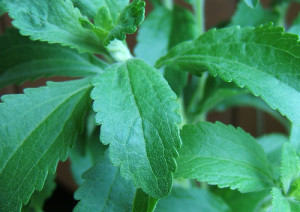 Start your spring off light and guilt free by enjoying the benefits of nature’s most amazing herbal sweetener, Stevia.
Start your spring off light and guilt free by enjoying the benefits of nature’s most amazing herbal sweetener, Stevia.
Stevia (Stevia rebaudiana) is a medicinal and culinary herb that is just now getting its fair and over due share of attention in the US. It is quite simply a fascinating plant that is 200-300 times as sweet as table sugar, remarkably has zero calories, and has the added bonus of being pretty easy to grow in your backyard garden!
Among the many unique qualities of this delicious herb, one that stands out is that it does not impact blood sugar levels in any way. I know, I know, do you hear the angels singing? That being said, it is perfectly safe for diabetics, folks with metabolic syndrome, and all the rest of us who don’t want the high and lows of the blood sugar rollercoaster. Artificial sweeteners, processed white sugars, and plant based sugars all may disturb insulin levels which are then exacerbated by imbalanced diets leading to premature aging and disease. Please, who wants to travel down that road? Don’t worry, I’m not suggesting you give up making your fave cookie recipes but it is definitely worth exploring the tastes of Stevia. Speaking of exploring…
The botanical roots lie with the Guarani Indians who used it to sweeten their Yerba Mate, a bitter tasting tea-like beverage. However, this leafs popularity spread west by the research done by botanist explorer Moises Santiago Bertoni who said “ A fragment of the leaf only a few square millimeters in size suffices to keep the mouth sweet for an hour, a few small leaves are sufficient to sweeten a strong cup of coffee or tea.” Are you intrigued yet?
Currently, Japan is the largest consumers of Stevia where it accounts for 40% of the sweetener market. It is also widely used in China, other parts of Asia, South and Central America and Mexico. Here in the US, this herb has been under FDA banishment until just recently. Stevia banned in 1991 was declared an unsafe food additive. In 1995, under great pressure from the Dietary Supplement Health and Education Act, the FDA changed its position to label stevia a dietary supplement but not quite a food additive. I’d say certain parties are artificially trying to sweeten someone in the FDA’s tea.
Use It!
But the people want to try it, grow it, and eat it, so I say go for it. There are a few cookbooks (The Stevia Cookbook) celebrating its taste and many places to buy it in its different forms. Stevia comes in powdered form that you can purchase at your local natural foods store or you can harvest and use the leaves from the plant itself. You lucky folks out there will be able to hop out to the garden and pick fresh leaves that are tasty to munch fresh off the stem. Crush or blend dried leaves by hand or in a spice/coffee grinder.
You may also begin to notice select restaurants and cafes offering packets of it side by side the pink, blue, and yellow packets. I am all for making room, er, perhaps pushing to the side or off the table those made in factories in favor of the more naturally sweet!
Stevia is perfect and delicious to use in many recipes especially to sweeten teas and beverages and in baking and cooking. To prepare a fresh leaf extract, bring one cup of water to a boil. Turn off water, add handful of stevia leaves and steep for 30 minutes. Use this infused tincture in desserts, drinks, and even in cocktails! Elizabeth says “why not?” We’ll let you know soon how those stevia sweetened Margaritas come out!
But a simple way to begin taste testing is to add several leaves of fresh, dried, or powdered stevia to tea or hot lemon water and enjoy.
Conversions:
3 tbsp chopped fresh stevia = 1 cup sugar
1 tsp stevia extract powder to 1 cup of sugar
Grow It:
You can grow Stevia in your own garden. It is best to plant in spring after danger of frost has past. You can buy a live stevia plant via mail order.
Plant stevia in full sun and give frequent shallow watering. Stevia is sensitive to cold and frost so bring in during winter in colder climates. My plants die back in winter and come back in spring. You can harvest throughout the growing season with a big harvest in fall before flowering. Leave about 4” above ground. Dry leaves in full sun all day.
To Propagate: You can take stem cuttings of Stevia in spring.
Action Item:
Ask your local coffee shop to carry it. Doctors and nurses, please suggest to your hospitals and clinics to carry Stevia. I hope you are just as excited to further explore the possibilities that exist with this herb. Let us know what you think!!
